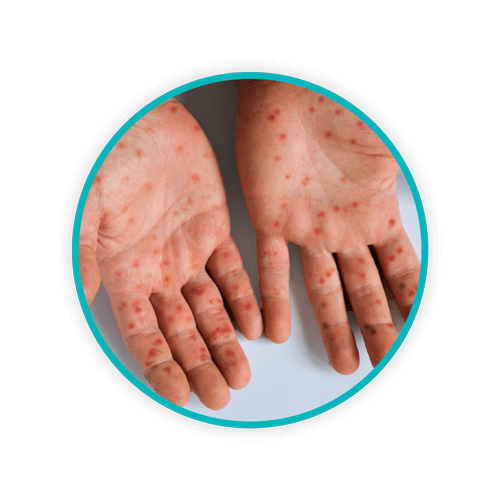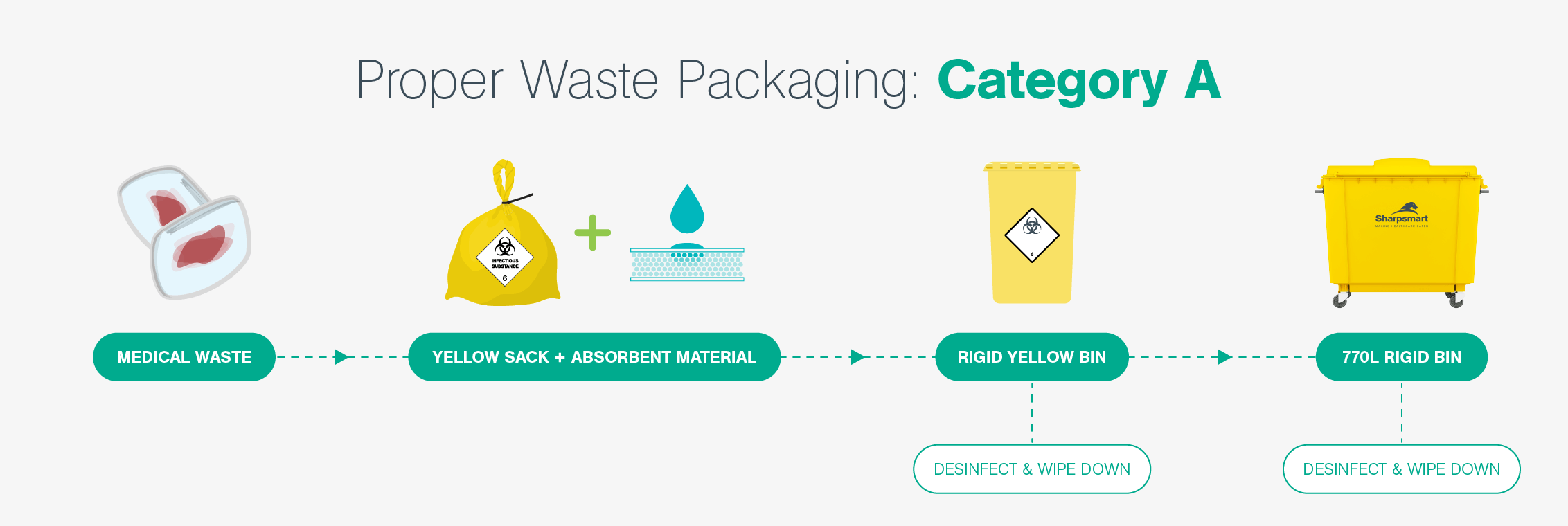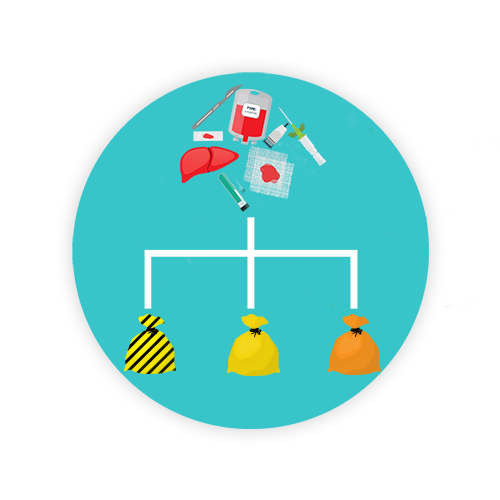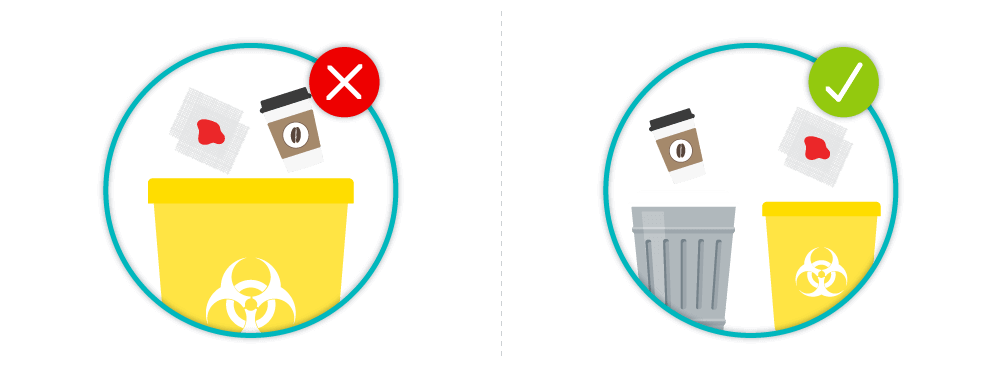Safely Managing Category A Infectious Waste in Healthcare Settings

Are you prepared to handle and dispose of Category A waste safely and in compliance?
In our previous blog, we focused on managing waste generated from patients with mpox, a Category B infectious disease. This article explores the stringent protocols necessary for handling Category A infectious waste within healthcare settings.
It’s important to note that this blog post primarily focuses on Category A waste management within clinical healthcare environments. Research laboratories often operate under different regulations, adhering to specific containment-level protocols – such protocols may require waste to be autoclaved or rendered safe by other means before it leaves the laboratory.
TOPICS WE WILL COVER:
2 / Types of Category A Diseases
3 / Examples of Category A Waste
4 / Precautionary Measures for Category A Waste Disposal
5 / How to Correctly Package Category A Waste
6 / Category A Waste Container Requirements
7 / Why Prepare for Category A Waste Disposal?
8 / Looking for Clinical Waste Guidance?
What is Category A Waste?
Category A waste comprises materials contaminated with pathogens that pose the highest risk of transmission with the potential to cause life-threatening diseases in humans or animals. These pathogens are highly virulent and can spread easily through various routes, including direct contact, airborne transmission, and contaminated objects.
But why are these diseases classified as Category A, demanding such stringent precautions?
Several factors contribute to this classification:
- High mortality rate: These diseases often have a high fatality rate if not treated effectively.
- Ease of transmission: They can spread readily between people, through direct contact, the air, or contaminated items.
- Limited treatment options: Effective treatments or preventative measures like vaccines are often lacking.
- Significant public health risk: They have the potential to cause widespread outbreaks with severe consequences.
 Types of Category A Diseases
Types of Category A Diseases
- Ebola: Has a high mortality rate, can spread through bodily fluids, and has limited treatment options.
- Lassa Fever: Spreads through rodent urine and droppings and can cause severe illness. Whilst there are some antiviral medications, they’re not always effective.
- Smallpox: Highly contagious with a historically high mortality rate. Although there is a vaccine, it’s not routinely used due to the disease’s eradication.
Examples of Category A Waste
Category A waste can be generated from various sources within a healthcare setting, including:
- Laboratory cultures and specimens: Any materials used to grow or store Category A pathogens.
- Patient care waste: Dressings, swabs, bodily fluids, and tissues from infected patients.
- Sharps: Needles, scalpels, and other sharp instruments used in the treatment or diagnosis of infected patients.
- Animal carcasses and tissues: From animals infected with Category A pathogens.
Precautionary Measures for Category A Waste Disposal
Due to the significant risk associated with Category A waste, healthcare professionals must adhere to strict precautionary measures:
- Personal Protective Equipment (PPE): This includes full-body protective suits, respirators, double gloves, eye protection, and face shields.
- Dedicated Waste Containers: Use UN-certified, leak-proof containers specifically designed for Category A waste. These are usually rigid and puncture-resistant.
- Segregation: Keep Category A waste separate from other waste streams at all times.
- Spill Management: Have a designated spill kit readily available and staff trained in proper spill cleanup procedures.
- Decontamination: All surfaces and equipment that come into contact with Category A waste must be thoroughly decontaminated.
How to Correctly Package Category A Waste

Category A waste requires a specific three-part packaging system for maximum containment:
1. Primary Container: A leak-proof container directly containing the waste. This should be robust and impervious to puncture. For sharps, this would be a sharps container. For soft waste, this could be sealed, double bags.
2. Secondary Container: A second leak-proof container that encloses the primary container. Absorbent material should be included in the secondary container to soak up any fluids.
3. Outer Container: A rigid outer container, often a UN-certified box or drum, that provides further protection and facilitates safe transport. This outer container is typically yellow in colour and should be clearly labelled with the biohazard symbol, the words ‘Category A Infectious Waste’ and the specific pathogen involved.
Packaging Category A Soft Waste
This includes items like dressings, soiled linen, and PPE. These should be placed in two yellow clinical waste bags, one inside the other, sealed tightly and then placed within the secondary container.
Packaging Category A Patient Care Waste
Patient care waste should be placed in two yellow clinical waste bags, one inside the other. The bags should be sealed tightly with a sack tie before being placed within the secondary container.
Packaging Category A Samples and Vials
Category A waste in sealed, leak-proof containers such as vials or sample tubes, can be placed directly into the secondary container. In this case, the vial or tube itself acts as the primary container.
Packaging Category A Sharps
Sharps must always be disposed of in designated sharps containers that are puncture-resistant and leak-proof. These sharps containers should then be placed within the secondary container.
It’s crucial to use single-use sharps containers; reusable sharps containers must never be used for Category A waste.
Category A Waste Container Requirements
All containers used for Category A waste must meet specific requirements:
- UN Certification: Ensures the containers meet international standards for transporting dangerous goods.
- Durability: Containers must be strong enough to withstand handling and transport without leaking or breaking.
- Leak-proof: Prevent any leakage of infectious materials.
- Labelling: Clearly labelled with the biohazard symbol, the words ‘Category A Infectious Waste’ and the specific pathogen involved.
Why Prepare for Category A Waste Disposal?
Whilst Category A diseases are rare in the UK, the potential consequences of an outbreak necessitate a proactive approach. Healthcare facilities must remain alert and ensure staff are properly trained in handling and disposing of Category A waste. Regular drills and simulations can help maintain this state of preparedness and ensure a swift and effective response in the event of a suspected or confirmed case.
Managing Category A infectious waste requires a high level of vigilance and adherence to strict protocols. Proper packaging, segregation, and handling are essential to protect healthcare workers, the public, and the environment.
By understanding and implementing these guidelines, healthcare facilities can ensure the safe and responsible disposal of Category A waste, minimising the risk of disease transmission and contributing to a safer healthcare environment.
Looking for Clinical Waste Guidance?
Whether you’re looking for some guidance on classifying and packaging your waste or a reliable clinical waste disposal service that puts you first, we’re here to help.
At Sharpsmart, our mission has always been to make healthcare safer and we’re dedicated to protecting healthcare workers and the environment. Our clinical waste experts work with your teams within the four walls of your organisation, empowering your staff to manage your waste in the most effective way possible.
If you’d like to discover how we can help improve your clinical waste management, please don’t hesitate to get in touch.
Let's Talk!
Your time is valuable, and we don’t want to play hard to get. You can either phone us directly on the details listed on our contact page, or feel free to fill out this short form and one of our team members will get back to you as quickly as possible.

